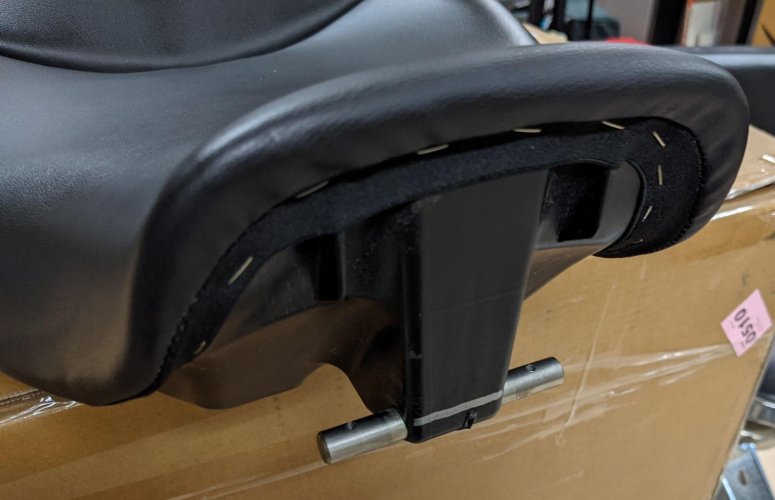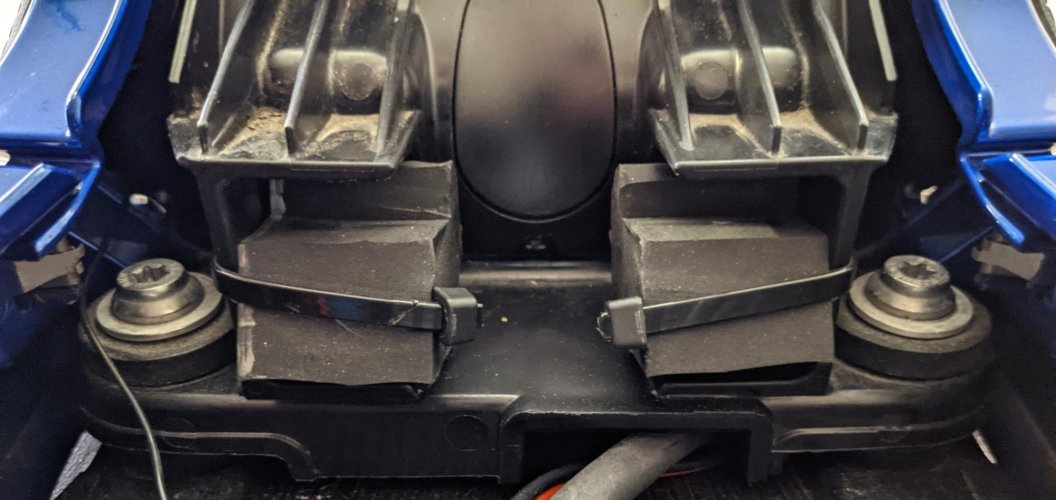JerryG
Member
I've always experienced some forward slipping on the seat of my 2021 XR that I didn't like. To fix that, I tried replacing the bushings at the front underside of the seat with a set of bushings with an offset hole. They were sold for the purpose of lowering the front end of the seat, but I thought rotating them 180 degrees would raise the front end. I was correct and it reduced the forward slipping nicely, but ultimately this idea failed because the weight of the seat and rider would cause the bushings to rotate the offset hole down to the bottom position thus lowering the seat unless you stopped and rotated them 180 degrees again and again. I also tried screws to hold the offset bushings, but the whole seat pin then rotated.
So, as another experiment, I cut a flat spot on the bottom of the offset hole bushings and cut a resting place for the seat pins on the top of the offset bushings; the idea being that the seat pins would sit on top of these modified offset bushings. This worked but I wanted something that would hold the front end up better and that would not slip out of position over time.
So, I bought some rubber block pieces intended to stiffen up shock springs (https://www.amazon.com/dp/B000AMBOFS?psc=1&ref=ppx_yo2_dt_b_product_details) and cut two of those pieces into a shape that would hold the seat in the higher position and then I cable tied those hand-cut bushings into the bushing receiver using a hole I drilled on the outside of each receiver. Visually, this raises the front of seat about 1/2 inch, right up to the overhanging lip of the gas tank. When I sit on the seat, the seat front is kept high while my weight bows the rest of the seat downward. This has definitely reduced my forward sliding. Pics below.
Installed, my new seat height at the front of the seat is show here...

...the front of the seat when removed looks like this...

...and the hand-cut bushings cable-tied into bushing receiver look like this...

On another forum, I received this reply on this subject:
"Those front bungs are just for locking in the seat, and avoid left/right motion. If you move those up the support rubbers are not seated and the belly pan is stressed beyond design. The 2020 has 6 supports, think the 2016+ had 8? So unless you strap height adjustements to the rear frame that's no good"
My response:
Thanks for bringing this up; it's an important point given what I'm doing.
Based on the location of the supports (under the rider, under the mid-seat, & under the passenger), I believe the front bungs are load bearing, but you are correct that lifting the front bungs does lift the rider support and mid-seat supports off the frame. The rider support gap is 5mm off the frame and the mid-seat support gap is 4mm off the frame (measured by slipping coins in the gap). The supports under the passenger are not easily observable, but I don't believe they are off the frame by much, if at all, because the seat locks in back with the same gentle downward push as before.
That said, I do not agree with your "no good" assessment. When I place the seat upside down on my knee and push down on both ends, the seat is not wholly rigid; it flexes quite a bit. When I install the seat and push down on it with just a few pounds of force, the supports quickly come in contact with the frame.
I'd say I'm actually using the seat pan's flex to create a slight upward slope from the middle of the seat to the front of the seat as I sit down. At this time, I have a few hundred miles with this setup and there is no sign of stress on the seat pan. I'll report back here after I have a few thousand miles; it shouldn't take long as I ride through the winter and last year I put 23,000 miles on this bike.
Again, thanks for brining this up.
So, as another experiment, I cut a flat spot on the bottom of the offset hole bushings and cut a resting place for the seat pins on the top of the offset bushings; the idea being that the seat pins would sit on top of these modified offset bushings. This worked but I wanted something that would hold the front end up better and that would not slip out of position over time.
So, I bought some rubber block pieces intended to stiffen up shock springs (https://www.amazon.com/dp/B000AMBOFS?psc=1&ref=ppx_yo2_dt_b_product_details) and cut two of those pieces into a shape that would hold the seat in the higher position and then I cable tied those hand-cut bushings into the bushing receiver using a hole I drilled on the outside of each receiver. Visually, this raises the front of seat about 1/2 inch, right up to the overhanging lip of the gas tank. When I sit on the seat, the seat front is kept high while my weight bows the rest of the seat downward. This has definitely reduced my forward sliding. Pics below.
Installed, my new seat height at the front of the seat is show here...

...the front of the seat when removed looks like this...

...and the hand-cut bushings cable-tied into bushing receiver look like this...

On another forum, I received this reply on this subject:
"Those front bungs are just for locking in the seat, and avoid left/right motion. If you move those up the support rubbers are not seated and the belly pan is stressed beyond design. The 2020 has 6 supports, think the 2016+ had 8? So unless you strap height adjustements to the rear frame that's no good"
My response:
Thanks for bringing this up; it's an important point given what I'm doing.
Based on the location of the supports (under the rider, under the mid-seat, & under the passenger), I believe the front bungs are load bearing, but you are correct that lifting the front bungs does lift the rider support and mid-seat supports off the frame. The rider support gap is 5mm off the frame and the mid-seat support gap is 4mm off the frame (measured by slipping coins in the gap). The supports under the passenger are not easily observable, but I don't believe they are off the frame by much, if at all, because the seat locks in back with the same gentle downward push as before.
That said, I do not agree with your "no good" assessment. When I place the seat upside down on my knee and push down on both ends, the seat is not wholly rigid; it flexes quite a bit. When I install the seat and push down on it with just a few pounds of force, the supports quickly come in contact with the frame.
I'd say I'm actually using the seat pan's flex to create a slight upward slope from the middle of the seat to the front of the seat as I sit down. At this time, I have a few hundred miles with this setup and there is no sign of stress on the seat pan. I'll report back here after I have a few thousand miles; it shouldn't take long as I ride through the winter and last year I put 23,000 miles on this bike.
Again, thanks for brining this up.



